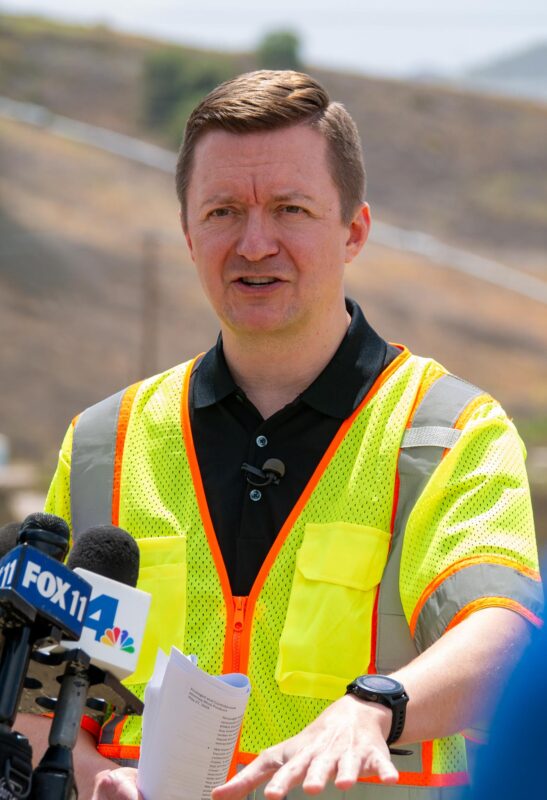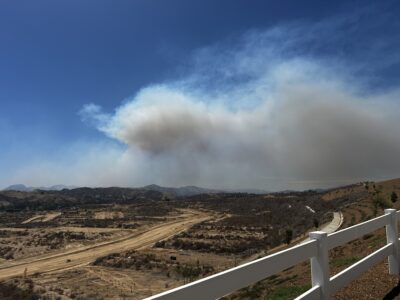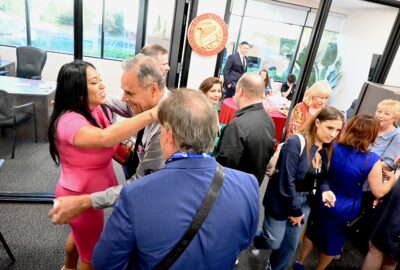Two nauseating smells — one likened to rotten milk, another, the acetone in nail polish remover — permeated Chiquita Canyon Landfill on Wednesday during an invite-only media tour of the now-shuttered facility, as Waste Connections, which owns the site, touted its progress there.
John Perkey, vice president and deputy legal counsel for Waste Connections, disputed the findings of state and federal regulators regarding the growth of the reaction area while convening a gaggle of reporters in an area he described as the reaction site.

Waste Connections said it was organizing the event after two years of working on problems at the landfill to share its progress with residents.
Perkey said the landfill has been working “hand-in-glove” with the site’s regulators to implement every mitigation measure possible to stop the reaction’s impact to the community. Landfill officials also said they wanted to “clarify any misinformation” circulating about the landfill, which included challenging the state’s findings that the reaction size had doubled.
State regulators announced the landfill’s reaction was growing about two weeks after the landfill announced it was no longer helping residents impacted by its pollution. The reason the landfill gave was that it had made such substantial progress in its cleanup that such assistance was no longer necessary.

Perkey said the landfill had installed four flares to help capture the landfill gases that have plagued residents, and officials were working on obtaining permission for more. There have been hundreds of wells installed as part of its gas- and liquid-extraction systems.
The landfill has installed 50 miles of pipes in an effort to capture the landfill odors, which is enough pipe to stretch from Castaic to Manhattan Beach, Perkey said.

At one point in explaining how rare the situation is, Perkey said there were only about 15 landfill events like Chiquita’s in the country, while there are more than 2,600 permitted municipal solid waste facilities.
When asked Wednesday to back up the site’s progress, Perkey repeatedly referred reporters to the landfill’s website, which is densely packed with hundreds of pages of technical reports.
Statements from the multiagency task force regulating the site have indicated the reaction area has grown from approximately 40 acres to roughly 90 acres, which is based on temperature readings and other measurements taken.

Perkey said that characterization was disputable “based on the original abatement order we received.” However, he did acknowledge the landfill was planning to expand the thick geomembrane cover already placed over about 46 acres.
Chiquita Canyon has installed hundreds of liquid and gas wells meant to trap the landfill gases and leachate being produced by the elevated temperature landfill event — a smoldering subsurface reaction that’s burning trash at approximately 245 degrees.

He also said there’s been no determination of the cause or a timeline for when the smells from the leachate or the gases might go away.
Despite two years of work at the site, the facility is still producing leachate at approximately 10 times its normal rate, about 200,000 gallons per day now versus an average of about 20,000 before the reaction was reported. Residents have launched more than 28,000 complaints that the South Coast Air Quality Management District has investigated and verified.

An April order from the AQMD Hearing Board requires Chiquita Canyon Landfill “to implement stronger measures to address persistent odors that have been impacting the community for nearly two years.”
The “new and modified requirements include minimizing spills and leaks, improving leachate tank systems, and conducting additional inspections,” according to the orders.
The tour involved two visits to sites where the leachate is being treated at the landfill, due to a limited number of places where leachate with chemicals like benzene in it can be taken for disposal, according to Perkey.
The landfill remains locked in a legal battle with Los Angeles County, which is trying to force Waste Connections to compensate residents — as well as lawsuits from about 2,000 of those residents who are also seeking compensation on their claims of health impacts from the pollution.
The landfill has a pair of status hearings next month: one is scheduled for June 4, the other June 17.
More information about the meetings is available here: bit.ly/3SmeomZ.









